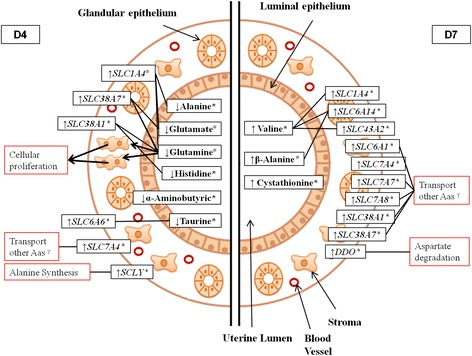Fig. 7.

Amino acid transport in the uterus of cows on D4 and D7 of diestrus. This figure shows the comparative abundance of transcripts related to amino acid (AA) transport and metabolism and the luminal concentration of AA between more receptive endometrium (Large Follicle-Large Corpus Luteum group) and less receptive endometrium (Small Follicle-Small Corpus Luteum group) on D4 and D7 after estrus. On D4, the transport of AA seems to occur preferentially from the uterine lumen towards endometrial cells, because despite elevated expression of genes related to AA transporters in endometrium there is lower availability of AA in uterine washings. Such direction of transport benefit events such as cell proliferation, which requires AA. On D7, AA availability in uterine lumen and abundance of genes related to AA transport are both stimulated in the more receptive endometrium. This phenotype is consistent with a greater provision of substrates to support embryonic needs for growth. ↑, up-regulated in LF-LCL group in comparison to SF-SCL group; ↓ down-regulated in LF-LCL group in comparison to SF-SCL group; γ, carriers related to transport of AAs similarly abundant in the lumen of both groups. solid lines connect a transporter with its cognate substrate(s); *, P ≤ 0.05; #, P < 0.1; SLC, Solute carrier protein; SCLY, Selenocysteine Lyase; DDO, D-aspartate Oxidase
